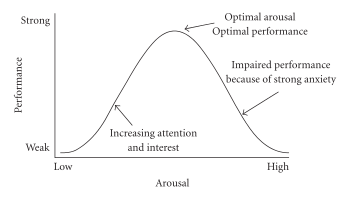Somatic anxiety
Somatic anxiety, also known as somatization, is the physical manifestation of anxiety.[1] It is commonly contrasted with cognitive anxiety, which is the mental manifestation of anxiety, or the specific thought processes that occur during anxiety, such as concern or worry. These components of anxiety are especially studied in sports psychology,[2] specifically relating to how the anxiety symptoms affect athletic performance.
Associated symptoms typically include "abdominal pain, dyspepsia, chest pain, fatigue, dizziness, insomnia, and headache".[1] These symptoms can happen either alone or in a cluster.
Research on somatic anxiety is increasing.[3] Studies have reported that some medically overlooked cases that could not relate physical pain to any type of organ dysfunction typically could have been somatic anxiety.[1]
Anxiety-performance relationship theories
[edit]Drive theory
[edit]The Drive Theory[4] suggests that if an athlete is both skilled and driven (by somatic and cognitive anxiety) then the athlete will perform well.[5]
Inverted-U hypothesis
[edit]
The Inverted-U Hypothesis,[6] also known as the Yerkes-Dodson law[6] hypothesizes that as somatic and cognitive anxiety (l) increase, performance increases until a threshold is crossed. Should arousal increase further, performance decreases.[5]
Multi-dimensional theory
[edit]The Multi-dimensional Theory of Anxiety[7] is based on the distinction between somatic and cognitive anxiety. The theory predicts that a negative, linear relationship between somatic and cognitive anxiety, an Inverted-U relationship between somatic anxiety and performance, and that somatic anxiety declines once performance begins although cognitive anxiety may remain high, if confidence is low.[8]
Catastrophe theory
[edit]Catastrophe Theory[9] suggests that stress, combined with both somatic and cognitive anxiety, influences performance, that somatic anxiety affects each athlete and each performance differently, limiting the ability to predict an outcome using general rules.[8]
Optimum arousal theory
[edit]Optimum Arousal Theory[10] states that each athlete performs best if their anxiety Alevel falls within an "optimum functioning zone".[5]
See also
[edit]References
[edit]- ^ a b c Gelenberg, A. J (2000). "Psychiatric and Somatic Markers of Anxiety: Identification and Pharmacologic Treatment". Primary Care Companion to the Journal of Clinical Psychiatry. 2 (2): 49–54. doi:10.4088/PCC.v02n0204. PMC 181205. PMID 15014583.
- ^ Rainer Martens; Robin S. Vealey; Damon Burton (1990), Competitive anxiety in sport, Human Kinetics, pp. 6 et seq, ISBN 9780873229357
- ^ Agnafors, Sara; Norman Kjellström, Anna; Torgerson, Jarl; Rusner, Marie (November 2019). "Somatic comorbidity in children and adolescents with psychiatric disorders". European Child & Adolescent Psychiatry. 28 (11): 1517–1525. doi:10.1007/s00787-019-01313-9. ISSN 1018-8827. PMC 6800882. PMID 30895480.
- ^ Zajonc, Robert B (1965). "Social Facilitation". Science. 149 (3681): 269–74. Bibcode:1965Sci...149..269Z. doi:10.1126/science.149.3681.269. JSTOR 1715944. PMID 14300526.
- ^ a b c "Competitive Anxiety". BrianMac. May 3, 2015. Retrieved October 8, 2015.
- ^ a b Yerkes, Robert M; Dodson, John D (1908). "The relation of strength of stimulus to rapidity of habit-formation" (PDF). Journal of Comparative Neurology and Psychology. 18 (5): 459–482. doi:10.1002/cne.920180503.
- ^ Martens, R. et al. (1990) The Development of the Competitive State Anxiety Inventory-2 (CSAI-2). Human Kinetics
- ^ a b McNally, Ivan M. (August 2002). "Contrasting Concepts of Competitive State-Anxiety in Sport: Multidimensional Anxiety and Catastrophe Theories". Athletic Insight. 4 (2): 10–22. CiteSeerX 10.1.1.629.5627.
- ^ Hardy, L. & Non Society for the Psychology of Sport and Physical Activity. Vancouver. June 1987.
- ^ Hanin, Yuri L. (2003-01-31). "Performance Related Emotional States in Sport: A Qualitative Analysis". Forum Qualitative Sozialforschung / Forum: Qualitative Social Research. 4 (1). ISSN 1438-5627.
